Hardware
How To Replace a Door Knob
Replacing door locks is a last resort. You have gotten this far, one of two things has happened. The lock is a goner and needs to be replaced. The other is, you decided that it looks terrible and a new one would look a lot nicer. Either way, you have to replace it.
For related information see the articles 'Troubleshooting Door Locks' and 'Troubleshooting Door Problems'.
Three things matter with a door lock. The size of the main bore, the size of the strike bore and the back set from the edge of the door. The back set is less of a problem than it used to be. Most new locks have adjustable back sets The two normal ones are 2 3/8" and 2 3/4". Most new locks support both dimensions. Does that 3/8" really matter? Well, yes. A 2 3/4" back set lock will not work in a door bored for 2 3/8".
Purchasing Door Locks
You will want to take the old lock out before you purchase the new one. Although locks have gotten more standardized over the years, there are still variations. Write down a few key dimensions before you go shopping.
Door locks start out a around ten dollars and can go up to over a hundred dollars. Like anything else, quality and appearance are big factors. Obtain a lock that will fit your door. Follow the instructions for installing it. Most of them work similarly. The strike cylinder goes in first and then the two halves of the door knob screw together with the key side facing out. One caution, lever locks are handed and not all of them can be reversed. Make sure you check this out if you obtain a lock with a lever handle.
Removing the Old Door Lock
Most of the time the only you tool you need is a phillips screw driver. Many, (but not all) residential door locks are held in place by two long machine screws. These are located on either side of the door knob on the inside of the room. When you unscrew them, the two halves of the door knob assembly should come apart.
The screws are fairly long, so if you use a hand screwdriver, it will take a little bit of time. It is best to alternate between the two screws so that you can pull the handle out part way. Otherwise the angle for the screwdriver may give you trouble.
Retaining Buttons
Some door knobs have a retaining clip that hold the knob on. Again this clip will be on inside of the room. It may be a long flat button or it may be a button inside of a small hole. You will need a small nail if it inside of a hole. You push in on the button and the door knob will release, allowing the cover plate to come off.
Inside of the cover plate you will find two screws that hold the main assembly together. Remove the screws and the two halves of the door knob will come apart.
Once the lock is taken apart, you can remove the strike assembly. This is held in place by two screws on the edge of the door. The strike plate is also held in place by two screws. If you are replacing the door knob you will need to remove all of these items.
Installing a New Door Lock
Once you have removed the old door lock, installing the new one is pretty simple. Again, assuming you have a lock that fits your door, you should only need a screw driver.
Installing the Strike Assembly
Most locksets have an adjustable backset, so they will fit a door that is either 2 3/8" or 2 3/4" to the center of the main bore. You may need to set the strike assembly to the correct backset before you install it. Take a quick look at the instructions. Once the backset is adjusted, intall the assembly with the two screws provided. Install the strike plate in the same mortise that it was in originally. If you have to trim it, use a sharp chisel, removing only enough wood for the plate to seat flush with the door jamb.
Installing the Lock
Put the half of the lock with the female cylinders that recieve the screws in first. Align the other half of the lock up with the screws and push the halves together. Make sure you start the machine screws with your fingers, getting them started by a couple of threads before you use the screw driver or power drill. Once the screws are tightened the lock is installed.
Test the function of the lock, make sure it closes, latches and opens correctly. Try locking the door and opening it with the key.
Lubricating Door Locks
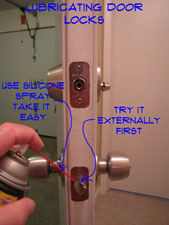 Lubricating door locks is an easy effective way to get them working smoothly. The door strike can be lubricated with the lock or knob still in place.
Lubricating door locks is an easy effective way to get them working smoothly. The door strike can be lubricated with the lock or knob still in place.
See the articles 'How To Fix a Door' and 'Repairing Door Locks' for a listing of door repair topics.
Purchasing Door Lock Lubricant
You want to use a silicone based non-staining spray to lubricate your locks. Graphite is not a good choice, since it can get on other surfaces and stain them.
Lubricating the Door Lock
Use some silicone spray and work the knob back and forth until it moves freely. The same may be true of the lock tumblers. Spray some lubricant inside the key hole. Use the key to work the tumblers until the oil sets in and the lock works.
The other moving parts of the lock will require that you remove the cover plates to lubricate them. Most locks are held together by two machine screws. The heads usually face the inside of the door. Residential grade locks can normally be taken apart with just a screwdriver. The lock should come apart in two pieces. The strike mechanism can stay in place once the knob and cover plates are removed.
Lubricate all the moving parts and work them until they move freely. Re-assemble the lock and the door should work. An old badly corroded lock or a broken lock, will probably not respond to just oiling it. A lock that is too far gone will need to be replaced. Check Step Six below for information on replacing a lock.
Adjusting Door Strike Plates
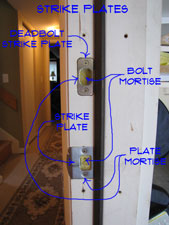
The strike plate receives the door latch and/or deadbolt for your door lock. If they don't line up the lock won't work properly.
If this is not your problem, see 'Door Repair' for all of the Door Repair topics.
Is the Door Adjusted Properly
Many problems with doors and hardware can be solved with some adjustment to the door. Assuming the carpenter installed the door correctly originally, what would cause it not to work now? Age and gravity are the two main things that will affect a door.
Over time, the weight of the door will cause it to sag. When that happens the door strike will not align with the strike plate. Tightening the hinges or adding a support screw may be all that is need to get the door working correctly.
Moving the strike plate should not be needed most of the time. Before you attempt to adjust the strike plate, make sure the door does not need to be adjusted. See 'Adjusting Interior Doors' and 'How To Adjust Exterior Doors' for more information and instructions on how to align the door.
If the door is adjusted properly, there would be two reasons to move the plate. One, the lock is not working right. Two, the door is not tight against the weatherstripping.
Moving a Strike Plate
The strike plate may need to move in or out slightly to allow the strike to seat correctly. Move it away from the center if the strike will not seat when the door is closed.
For an exterior door you want the door to snug up against the weatherstripping. To snug the door up you would move the strike plate toward the center of the door jamb. Move it away from the center if the strike will not seat when the door is closed.
For minor adjustments, you may be able to loosen the plate and tap it in the direction you need.
Use a screwdriver to loosen the screws slightly. Use a block of wood and a hammer to tap the strike plate in the right direction. Hold it in place and tighten the screws.
Chiseling the Mortise
Moving the strike plate any significant amount will involve removing it and chiseling out the mortise. Use the screwdriver and remove the strike plate.
With a sharp pencil draw an outline of where it needs to be on the jamb. With a sharp chisel you can trim out the wood up to the line. Moving the plate slightly will give you a problem with the screw holes.
You might need to whittle a little filler pin and glue it in place. This will give the screws a place to grab in their new location. Otherwise they will want to go back into the old location.
When the glue dries you can trim the pins off with the chisel and install the strike plate. Depending on which way you moved it, you may need to trim the mortise, the one where the strike seats. With the strike plate properly located the door lock should work.
Summary
Did you need to adjust your strike plate, or was it the door out of adjustment? Moving or adjusting a strike plate is not that difficult, hopefully you were able to solve the problem.
Adjusting Doors to Locks
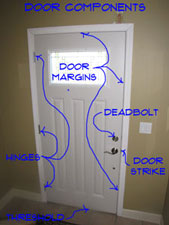 Adjusting doors to locks is needed when the door is out of alignment.The first thing to do is look at the door from the inside when it is closed. There should be an even gap across the top and down the latch side. This gap occurs between the door and the frame or jamb. It should be about an eighth of an inch and be consistent.
Adjusting doors to locks is needed when the door is out of alignment.The first thing to do is look at the door from the inside when it is closed. There should be an even gap across the top and down the latch side. This gap occurs between the door and the frame or jamb. It should be about an eighth of an inch and be consistent.
Some related information can be found in the articles 'How To Fix a Door', 'Fixing Interior Doors' and 'Repairing Exterior Doors'.
If the door is tight against the frame at the top and there is a gap at the bottom, the door is sagging. If the door is hitting the floor, it will still be indicated in the margin along the latch side. Is the gap wider at the bottom and narrower at the top? Yes, then the door is sagging. If the door is sagging you need to make a door lock repair.
Open the door back up and remove the two inner screws for the top hinge. How long are they? An inch or less? This means that the hinge is only being supported by the door jamb itself, not the framing lumber for the wall. Are the screws long, say 2 ½ to 3 inches. That's good, all you will need to do is tighten them up. This door lock repair might be that easy.
If you have long screws, make sure the heads are not stripped. For short screws you need to obtain some 3” number 8 screws. Square or Torx drive are better, but phillips head will work.
Install the long screws, angling them slightly toward the center of the jamb. Snug them up and then check the margins again. Still sagging? Tighten them a quarter turn at a time until the margins are even and the door closes properly.
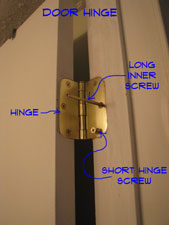 More is not better in this situation. If you over tighten, the door will bind in another direction. Tighten until the margins are even and the door closes easily and then stop. Make sure the strike and the deadbolt are lined up with the mortises and strike plates.
More is not better in this situation. If you over tighten, the door will bind in another direction. Tighten until the margins are even and the door closes easily and then stop. Make sure the strike and the deadbolt are lined up with the mortises and strike plates.
A properly aligned door will allow the lock and deadbolt to work correctly. This was not quite a door lock repair, but it got you to the same place, a working door.
Troubleshooting Door Lock Problems
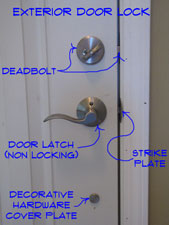 What does troubleshooting door lock problems involve? Before you decide that a door lock is not working, you need to make sure that the door is adjusted properly. If the dood is adjusted, then you can troubleshoot the locks and deadbolts.
What does troubleshooting door lock problems involve? Before you decide that a door lock is not working, you need to make sure that the door is adjusted properly. If the dood is adjusted, then you can troubleshoot the locks and deadbolts.
Not sure if this is your problem? See the article, 'Troubleshooting Door Problems' for a full listing of door problems.
Adjusting the Door
Many times the complaint is about the door hardware. It always seems to be the thing that is not working. Like a medical problem, this is what we call a symtom.
Door hardware only works properly on a door that is aligned the way it should be. The tolerances on doors and hardware is fairly narrow. If a door is sagging, the lock will not latch correctly. Not really the fault of the lock.
Before you consider replacing door hardware, you want to make sure the door is adjusted to allow the hardware to work. See the articles 'Adjusting Exterior Doors' and 'Interior Door Adjustment' for instructions on getting the door in proper alignment.
Troubleshooting Door Lock Issues
Is the key is broken off in the lock?
The Deadbolt is stuck!
Is it difficult to get the latch to engage?
Does the door not stay closed?
This usually indicates that the strike plate needs to be adjusted or the door strike is sticking and needs to be lubricated. The door strike is spring loaded and flat on one side. It needs to spring into the recess in the door strike to keep the door closed.
See the article 'Adjusting Door Strike Plates' for directions on how to fix a poorly aligned strike plate.
The Lock Won't Latch At All
A door that is sagging may cause the door strike to hit the strike plate to low, not allowing it to spring into place. Check the margins on the door. Is the top of the door closer to the jamb on the strike side of the door? If so the door is sagging.
A sagging door needs to be adjusted. See the articles 'Adjusting Exterior Doors' and 'Interior Door Adjustment' for information on how to adjust a door.
The Door Latch is Sticking
When the strike is lined up correctly and still won't keep the door closed you want to make sure it is working. Use your finger to check it. Depress the door strike and let go. It should pop back out freely. If it sticks you need to lubricate it. See the article 'Lubricating Door Locks' for more information.
Does the Door Latch When You Push On It?
If it pops back out freely try putting extra pressure on the door when you close it. Does the strike pop into place when extra pressure is applied to the door? An adjustment to the strike plate will solve the problem. See the article 'Adjusting Door Strike Plates' for directions on how to adjust a strike plate.
The door Knob is Hard to Turn
Is the door knob hard to turn, sticking or hanging up. If the lock has a key, the key may be sticking or not working. Lubricating the lock set will probably take care of it, see Step Four. On rare occasions the lock may be hanging up in the mortises. You can take the knob off and check to see if things are moving freely. By checking the various steps you can make your own door lock repair.
See the article 'Lubricating Door Locks' for more information.


